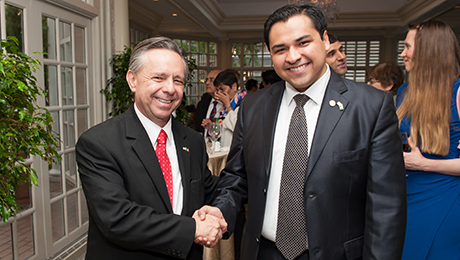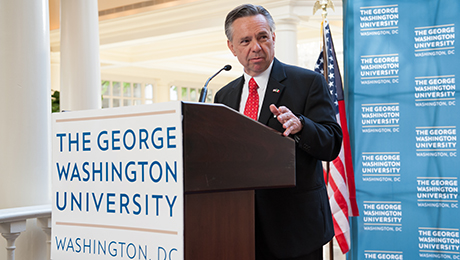By James Irwin
As Mexico aims to send 100,000 students to U.S. colleges and universities by 2018 and the United States announces plans to encourage 50,000 U.S. students to go to Mexico for study, a pair of programs at the George Washington University is increasing opportunities for cultural interaction between the neighboring countries.
GW's Carlos Slim Scholars program and Mexican Students Association (MXGWU) were cited several times Thursday evening during a speech given by Mexican Ambassador to the United States Eduardo Medina Mora on trade and community relations between the United States and Mexico. The ambassador was the keynote speaker at a reception co-hosted by GW’s Division of Development and Alumni Relations and the Mexican Students Association.
These programs, Amb. Medina Mora said, are "strengthening the bond between Mexico and the United States" at a time when greater cooperation and focus is needed, as the two countries continue to push forward with the 100,000 Strong in the Americas effort. The United States and Mexico are calling on universities in both countries to creatively participate in ways that fit their missions. GW’s “Vision 2021” strategic plan places an emphasis on globalization, governance and policy, and citizenship and leadership.
 Thursday's event in D.C. was attended by about 100 alumni, faculty, staff and students, and included discussions with Amb. Medina Mora about higher education initiatives between the United States and Mexico.
Thursday's event in D.C. was attended by about 100 alumni, faculty, staff and students, and included discussions with Amb. Medina Mora about higher education initiatives between the United States and Mexico.
According to the Institute of International Education’s Open Doors report on international student trends, 819,644 international students studied in the United States in 2012-13. Mexico, with a population of more than 120 million, accounted for less than 2 percent of those students. Of the 283,332 U.S. students studying overseas in 2011-12, only 3,815 studied in Mexico. Those are numbers that have plateaued and must increase, Amb. Medina Mora said, considering the populations and proximity of the two nations, and the critical importance of their mutual trade, environmental and security interests.
Nearly 34 million Hispanics of Mexican origin reside in the United States, according to a 2013 Pew Research Center report. Mexico was the United States’ second-largest goods export market in 2013.
The Carlos Slim Scholars program, established in 2012, awards full, merit-based tuition scholarships to top Mexican graduate students enrolled in two-year master’s degree programs in engineering, business and international affairs. The Mexican Students Association, which launched last year, has provided a venue for students to learn and connect with Mexico by hosting academic, cultural and social events, including discussions with Mexican state of Querétaro Governor José Eduardo Calzada and Margarita Zavala, former First Lady of Mexico. Included in the association are Fulbright scholars, funded scholars from Mexico's National Council of Science and Technology (CONACYT), students who have come to GW individually, and the Slim Scholars cohort. MXGWU welcomes students of Mexican heritage whatever their nationality.
 Carlos Slim scholar Javier Arreola Rosales, right, co-founded the Mexican Students Association last year.
Carlos Slim scholar Javier Arreola Rosales, right, co-founded the Mexican Students Association last year.
The Carlos Slim Scholars program and the student group are linked in many ways. Association co-founders Javier Arreola Rosales and Benjamín Heras Cruz are Carlos Slim scholars. Their work in founding the group is an example of the ambition and skill Carlos Slim scholars have, said Donna Scarboro, associate provost for international programs. And the location of the Mexican Embassy (the 1900 block of Pennsylvania Avenue) has helped make campus programs with notable guests, including Amb. Medina Mora, a reality.
“The Embassy of Mexico is closer to my office in Rice Hall than the Elliott School of International Affairs,” GW Provost Steven Lerman said. But beyond that, he added, exists a strong tie between the institution and the country.
“We have M.B.A. students who travel to work on U.S.-Mexican business ties, visiting faculty scholars from Mexico who do research work in the United States,” he said. “It’s only through these deep people-to-people connections that you build cultural exchange. It’s not edu-tourism where you go somewhere for a week or two and take a skim of the surface. These are deep learning experiences among students and faculty that should be treasured, nurtured and expanded.”
Students may be a catalyst for that development, Mr. Arreola Rosales said.
“So often we hear ‘young people are our future,’” he said. “Young people can be our present.”


